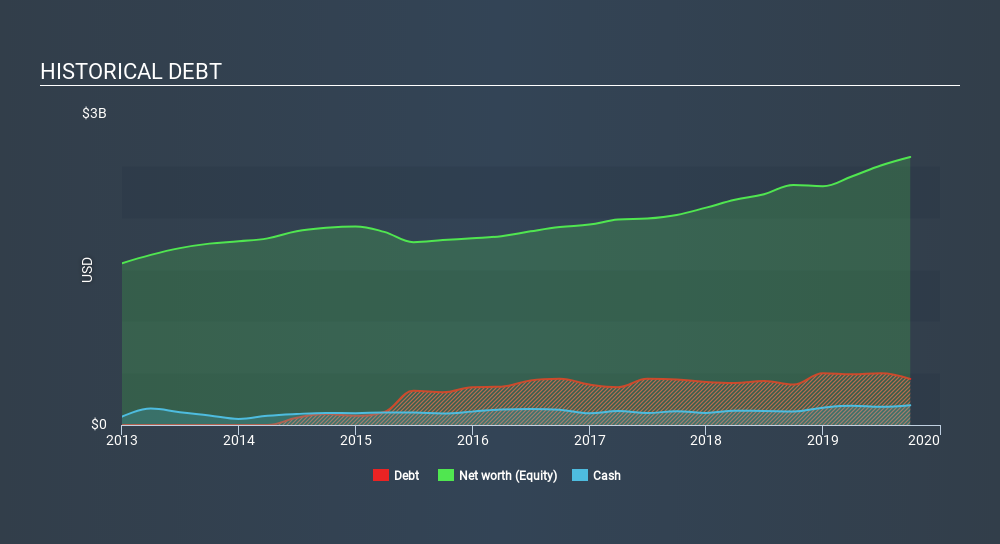Warren Buffett famously said, ‘Volatility is far from synonymous with risk.’ When we think about how risky a company is, we always like to look at its use of debt, since debt overload can lead to ruin. Importantly, Fastenal Company (NASDAQ:FAST) does carry debt. But the more important question is: how much risk is that debt creating?
When Is Debt Dangerous?
Debt and other liabilities become risky for a business when it cannot easily fulfill those obligations, either with free cash flow or by raising capital at an attractive price. If things get really bad, the lenders can take control of the business. However, a more usual (but still expensive) situation is where a company must dilute shareholders at a cheap share price simply to get debt under control. Of course, the upside of debt is that it often represents cheap capital, especially when it replaces dilution in a company with the ability to reinvest at high rates of return. When we think about a company’s use of debt, we first look at cash and debt together.
View our latest analysis for Fastenal
What Is Fastenal’s Debt?
As you can see below, at the end of September 2019, Fastenal had US$445.0m of debt, up from US$390.0m a year ago. Click the image for more detail. However, it also had US$191.2m in cash, and so its net debt is US$253.8m.

How Healthy Is Fastenal’s Balance Sheet?
Zooming in on the latest balance sheet data, we can see that Fastenal had liabilities of US$555.1m due within 12 months and liabilities of US$673.4m due beyond that. Offsetting this, it had US$191.2m in cash and US$817.3m in receivables that were due within 12 months. So it has liabilities totalling US$220.0m more than its cash and near-term receivables, combined.
Having regard to Fastenal’s size, it seems that its liquid assets are well balanced with its total liabilities. So while it’s hard to imagine that the US$20.5b company is struggling for cash, we still think it’s worth monitoring its balance sheet. But either way, Fastenal has virtually no net debt, so it’s fair to say it does not have a heavy debt load!
We measure a company’s debt load relative to its earnings power by looking at its net debt divided by its earnings before interest, tax, depreciation, and amortization (EBITDA) and by calculating how easily its earnings before interest and tax (EBIT) cover its interest expense (interest cover). Thus we consider debt relative to earnings both with and without depreciation and amortization expenses.
Fastenal has a low net debt to EBITDA ratio of only 0.21. And its EBIT covers its interest expense a whopping 72.0 times over. So we’re pretty relaxed about its super-conservative use of debt. The good news is that Fastenal has increased its EBIT by 8.5% over twelve months, which should ease any concerns about debt repayment. When analysing debt levels, the balance sheet is the obvious place to start. But ultimately the future profitability of the business will decide if Fastenal can strengthen its balance sheet over time. So if you want to see what the professionals think, you might find this free report on analyst profit forecasts to be interesting.
Finally, while the tax-man may adore accounting profits, lenders only accept cold hard cash. So it’s worth checking how much of that EBIT is backed by free cash flow. Over the most recent three years, Fastenal recorded free cash flow worth 51% of its EBIT, which is around normal, given free cash flow excludes interest and tax. This free cash flow puts the company in a good position to pay down debt, when appropriate.
Our View
The good news is that Fastenal’s demonstrated ability to cover its interest expense with its EBIT delights us like a fluffy puppy does a toddler. And the good news does not stop there, as its net debt to EBITDA also supports that impression! Looking at the bigger picture, we think Fastenal’s use of debt seems quite reasonable and we’re not concerned about it. After all, sensible leverage can boost returns on equity. We’d be motivated to research the stock further if we found out that Fastenal insiders have bought shares recently. If you would too, then you’re in luck, since today we’re sharing our list of reported insider transactions for free.
If you’re interested in investing in businesses that can grow profits without the burden of debt, then check out this free list of growing businesses that have net cash on the balance sheet.
If you spot an error that warrants correction, please contact the editor at editorial-team@simplywallst.com. This article by Simply Wall St is general in nature. It does not constitute a recommendation to buy or sell any stock, and does not take account of your objectives, or your financial situation. Simply Wall St has no position in the stocks mentioned.
We aim to bring you long-term focused research analysis driven by fundamental data. Note that our analysis may not factor in the latest price-sensitive company announcements or qualitative material. Thank you for reading.

The easiest way to discover new investment ideas
Save hours of research when discovering your next investment with Simply Wall St. Looking for companies potentially undervalued based on their future cash flows? Or maybe you’re looking for sustainable dividend payers or high growth potential stocks. Customise your search to easily find new investment opportunities that match your investment goals. And the best thing about it? It’s FREE. Click here to learn more."fast" - Google News
November 25, 2019 at 06:35PM
https://ift.tt/2KRD0S6
We Think Fastenal (NASDAQ:FAST) Can Stay On Top Of Its Debt - Simply Wall St
"fast" - Google News
https://ift.tt/2VRmxBz
Shoes Man Tutorial
Pos News Update
Meme Update
Korean Entertainment News
Japan News Update
No comments:
Post a Comment